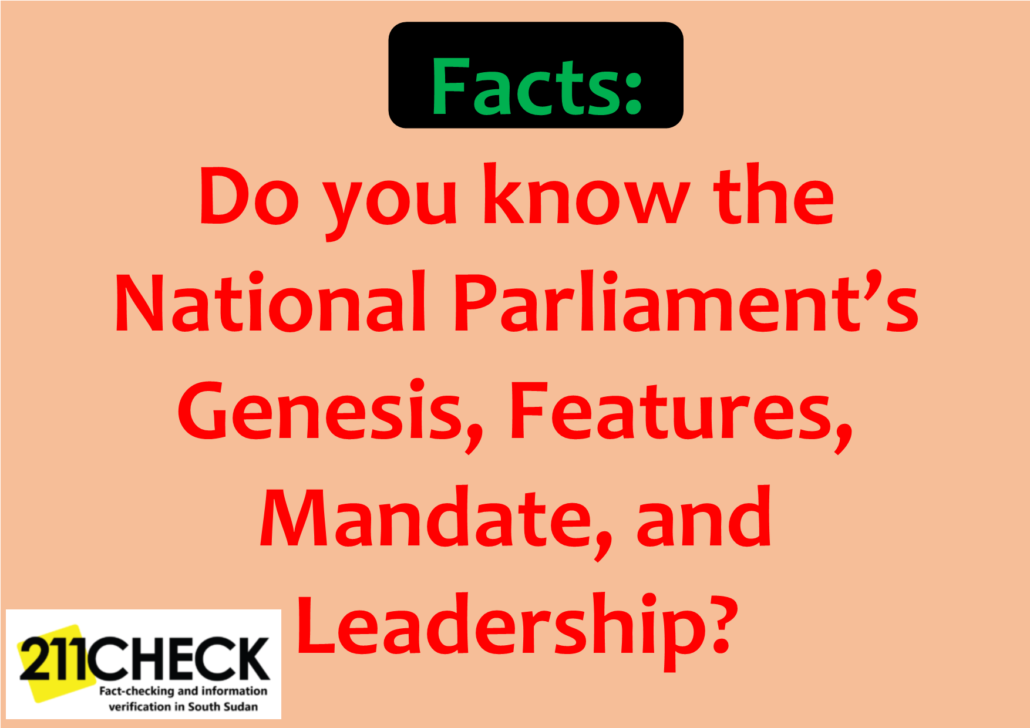EXPLAINER: Facts about the National Parliament
Author: Emmanuel Bida
South Sudan’s President Salva Kiir Mayardit weeks ago reconstituted the Transitional National Transitional Legislative Assembly, as stipulated in the revitalized peace agreement.
The reconstituted national assembly now consists of 550 lawmakers, drawn from all political parties that signed the peace accord in the Ethiopian Capital Addis-Ababa on September 12, 2018. There was an addition of 150 MPs to the previous list.
President Kiir’s appointment came a day after he dissolved the Transitional National Legislative Assembly and the Council of States.
According to the deal, both R-TNLA and Council of States shall be reconstituted to include new appointees from all peace parties.
The agreement recommends for the expansion of the TNLA from 400 to 550 members, consisting of representatives from the peace signatories.
It required the incumbent Transitional government to nominate 332 MPs, 128 from SPLM-IO, 50 from South Sudan Opposition Alliance, 30 from Other political parties and 10 from the Former Detainees – a provision that is fully implemented by all parties.
The genesis of the National Legislative Assembly
Under South Sudan’s 2011 transitional constitution as amended, the legislative power was bicameral, comprising the National Legislative Assembly (NLA) and the Council of States.
After the South’s independence from Sudan on July 9, 2011, the assembly which was established in August that very year, comprised a 332-member National Legislative Assembly and a 50-member Council of States.
The NLA body consisted of members of the previous regional legislative body, the South Sudan Legislative Assembly, and South Sudanese who had seats in Sudan’s National Assembly.
The majority of NLA members were directly elected; the rest were elected from closed lists to ensure proportional representation for women and various other groups, according to data obtained online.
Upon independence, the Council of States consisted of all South Sudanese who had been elected by state legislatures to seats in Sudan’s Council of States, as well as 20 members appointed by South Sudan’s president.
The 170 lawmakers of the National Legislative Assembly and the 50 member Council of States members were to serve four-year terms.
However, after the signing of the 2015 peace agreement on the Resolution of the Conflict in the Republic of South Sudan (R-ARCSS), a 400-member Transitional National Legislative Assembly was established on August 4 2016, which replaced the National Legislative Assembly.
The term of the Transitional National Legislative Assembly was to run concurrently with the Transitional Government of National Unity (T-GoNU) until elections were held.
During the transitional period, the 50-member Council of States, established in 2011, continued to function as the upper chamber of parliament.
Current framework
Following the civil war that broke out in December 2013, a peace agreement signed in August 2015 provided for the creation of a transitional power-sharing government that would include members of Kiir’s administration as well as members from the rebel groups.
The TNL was implemented in April 2016 and was intended to function for 30 months, with, among its tasks, the goal of organizing elections 60 days prior to the end of the transitional period.
According to the deal, the incumbent president remained in place and appointed a first vice president Dr. Riek Machar, who led SPLM-IO during the negotiations.
After the creation of the transitional government, the administration had 90 days to transform the NLA into the TNLA, which included former MPs, plus an additional 68 members.
Of the new 68 members, the matrix shows 50 were from the South Sudan Armed Opposition, 1 former detainee, and 17 from Other Political Parties.
The other legislative body, the Council of States, remained unchanged in the new transitional government.
R-TNLA’s mandate
The national legislature serves as an independent arm of the government and below in brief are some of the roles plays or should play: –
- Overseeing the performance of the National Government institutions.
- Approving plans, programs, and policies of the National Government.
Approving budgets;
3. Ratifying international treaties, conventions, and agreements.
4. Adopting resolutions on matters of public concern.
5. Summoning Ministers to answer questions of members of the Assembly on matters related to their ministries.
6. Interrogating Ministers about their performance or the performance of their ministries.
7. Approving appointments as required by the Transitional Constitution or the law.
8. Casting a vote of no confidence against the Vice President and any Minister.
9. Enacting legislation to regulate the conditions and terms of service of the Judiciary and its oversight mechanisms.
10. And performing any other function as determined by the Transitional Constitution or the law.
Eligibility
In accordance to the constitution, candidate for membership of the National Legislature must:
· be a South Sudanese.
· be at least twenty-one years of age.
· be of sound mind.
· be literate.
· A person who has not been convicted during the last seven years of an offense involving honesty or moral turpitude.
NOTE: Members of the National Legislature and the Council of Ministers are eligible for membership of state legislatures or state councils of ministers.
However, a member of the National Legislative Assembly cannot also be a member of the Council of States (and vice versa).
Previous NLA/TNLA Leadership
| Name | Took office | Left office |
| James Wani Igga | 2011 | August 2013 |
| Manasseh Magok Rundial | August 2013 | 4 August 2016 |
| Anthony Lino Makana | 4 August 2016 | 8 December 2019 |
| Obuch Ojok | 16 December 2019 | Incumbent |
What does the revitalized agreement say?
The Reconstituted Transitional National Legislative Assembly and the Council of States shall consist of the Transitional National Legislative Assembly (TNLA) and the Council of States.
The R-TNL shall be expanded to five hundred and fifty (550) members and reconstituted as follows: –
Incumbent TGoNU – 332 members
SPLM/A-IO – 128 members
SSOA: fifty – 50 members.
OPP: thirty – 30 members.
FDs: – 10 members.
The 2018 accord says the Speaker of the TNLA shall be nominated by the Incumbent TGoNU, one Deputy Speaker shall be nominated by SPLM/A-IO. Another one, who should be a woman, shall be nominated by the Incumbent TGoNU; and a third Deputy Speaker to be nominated by OPP.
The agreement says upon issuing the final report of the Independent Boundaries Commission (IBC) in accordance with Article 1.14, the Council of State shall be reconstituted as shall be recommended by the IBC.
However, if the IBC fails to issue its final report, the Council of State shall be reconstituted pursuant to the outcome of the referendum.
The deal added that without prejudice to the recommendations of the IBC, the Speaker of the Council of States shall be nominated by SPLM/A-IO, Deputy Speaker shall be nominated by Incumbent TGoNU, and shall be a woman, and Deputy Speaker shall be nominated by SSOA.
It stressed that for the purpose of regional inclusivity required in a body representing the States, each of the Speaker and Deputy Speakers shall come from former regions.
R-TNLA duration
The duration and term of the reconstituted TNL shall run concurrently with that of the RTGoNU, as per the terms of this Agreement, until such time as elections are held.
The functions and mandate of the TNLA shall remain as stipulated in the Transitional Constitution of the Republic of South Sudan, 2011 as amended, unless otherwise specified by the terms of this Agreement.
The reconstituted TNLA shall, in the conduct of its business, support this Agreement and enact legislation that enables and assists the transitional processes and reforms described in this Agreement.
Decisions in the reconstituted TNLA on matters pertaining to this Agreement shall be by consensus and failure to that, shall be by two thirds (2/3) majority of all the members.
Decisions in the TNLA on other matters not related to this Agreement shall be by consensus and in lieu of that by simple majority.
REFERENCES
http://archive.ipu.org/parline-e/reports/2390.htm
End


